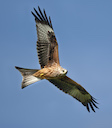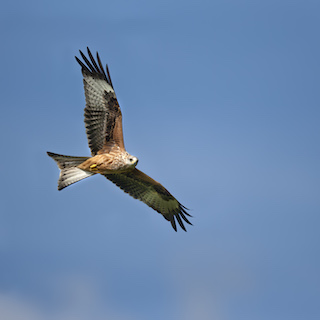 Red Kites are magnificent raptors – watch out for them soaring above the Lizard.
Red Kites are magnificent raptors – watch out for them soaring above the Lizard.
Photo: © Richard Birchett
Scientific name: Milvus milvus
Conservation status: Birds of Conservation Concern in the UK, amber-listed; IUCN Red List, near-threatened
What to look for:
- Colouring and appearance: This Buzzard-sized raptor has rufous (chestnut-coloured) upper and lower parts and a pale head. Its angled wings are rufous and brown above and below with black tips, but with obvious white patches on the underwing. The tail is forked.
- Size: Similar size to the more widespread Buzzard, with a wingspan of almost 2 m.
- Where: Red Kites nest and roost in woodland, but fly over open land searching for food.
- Call: High-pitched call
- Similar species: Other larger raptors, although the Red Kite’s colouring and forked tail are distinctive.
 The chestnut plumage of a Red Kite gliding effortlessly by, soaring with the thermals as it hunts for food, seems completely at ease in the British countryside. It is therefore hard to credit that this beautiful bird was hunted almost to extinction, with only a very small population remaining in Wales by 1900, because it was believed that it regularly took livestock and game. In fact, although it will opportunistically take small mammals, the Red Kite is mainly a carrion feeder. A long-term reintroduction programme, led by Natural England, the RSPB and Scottish National Heritage has now seen great success in reintroducing Red Kites to parts of England and Scotland: there are now 1,600 breeding pairs in the UK.
The chestnut plumage of a Red Kite gliding effortlessly by, soaring with the thermals as it hunts for food, seems completely at ease in the British countryside. It is therefore hard to credit that this beautiful bird was hunted almost to extinction, with only a very small population remaining in Wales by 1900, because it was believed that it regularly took livestock and game. In fact, although it will opportunistically take small mammals, the Red Kite is mainly a carrion feeder. A long-term reintroduction programme, led by Natural England, the RSPB and Scottish National Heritage has now seen great success in reintroducing Red Kites to parts of England and Scotland: there are now 1,600 breeding pairs in the UK.
Red Kites tend to pair for life and are generally faithful to the same breeding site and territory. They make an untidy nest in a tree fork, lined with scavenged materials, in which the female lays up to four eggs in April. The female does most of the incubation while the male stays close by to protect the eggs from predators. After hatching, the young are fed by the parents for about four weeks, and after becoming independent may travel long distances before establishing their own territories. The young birds reach breeding maturity at about three years old: non-breeding birds can be seen all over Britain.
Although now protected under the Wildlife and Countryside Act 1981, Red Kites are sometimes still poisoned. They are not always the target, but their carrion-eating habits mean they will pick up bait aimed at other animals, or scavenge corpses (such as rats) that have been poisoned and died.
Did you know…?
…The large wingspan but relatively small weight of Red Kites makes them very agile: they can stay aloft for a long time without beating their wings
…Well-dressed: Red Kites line their nests with a variety of scavenged human-made articles, even taking clothes from washing lines
More information and references:
Gooders, J. and Harris, A., 1986. Field Guide to the Birds of Britain and Ireland. Kingfisher Books, London.
Published: May 2014 (updated May 2020)
Author: Amanda Scott
Photos: © Richard Birchett (website and YouTube page)
